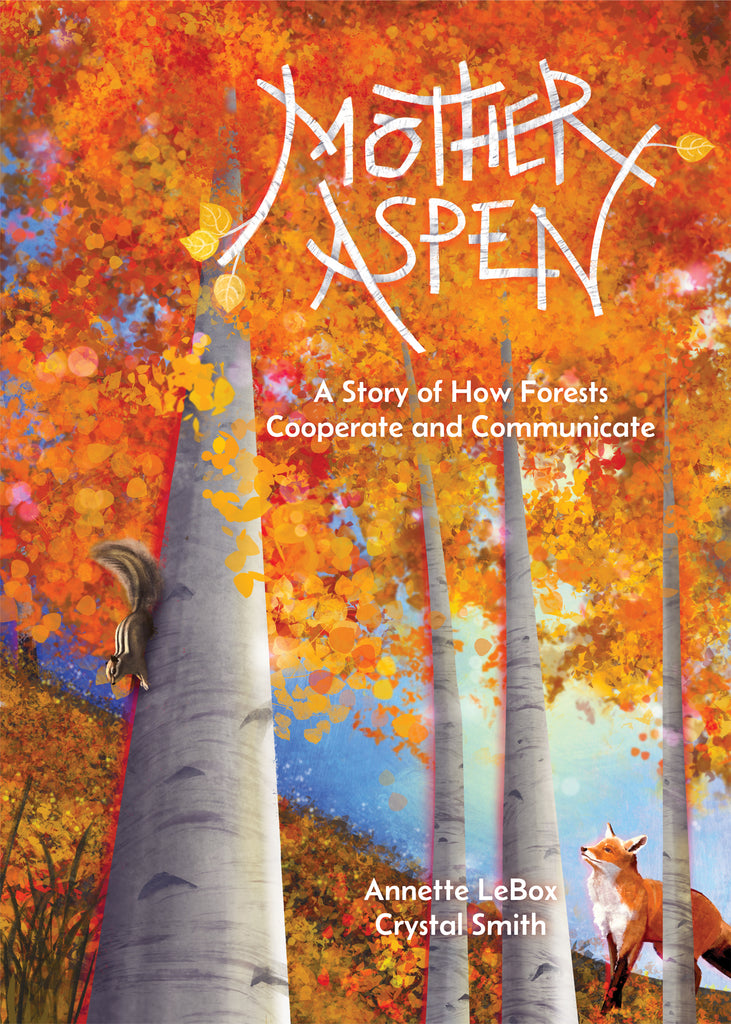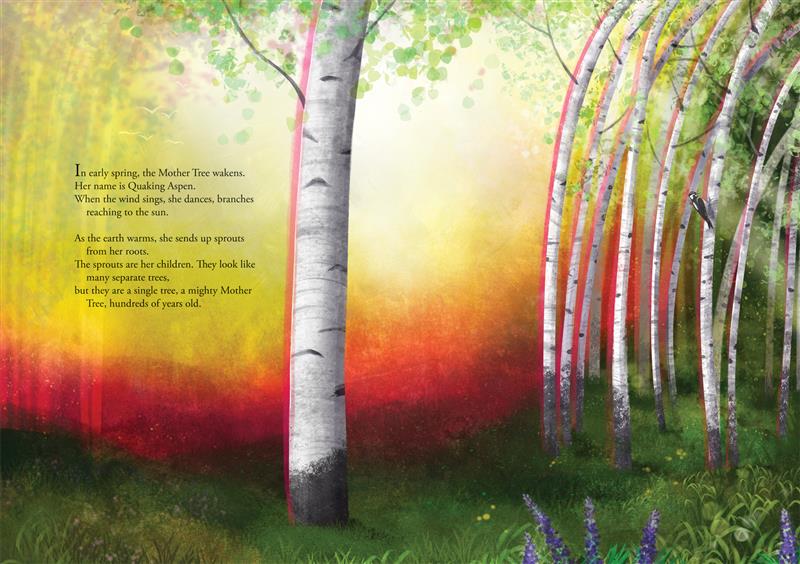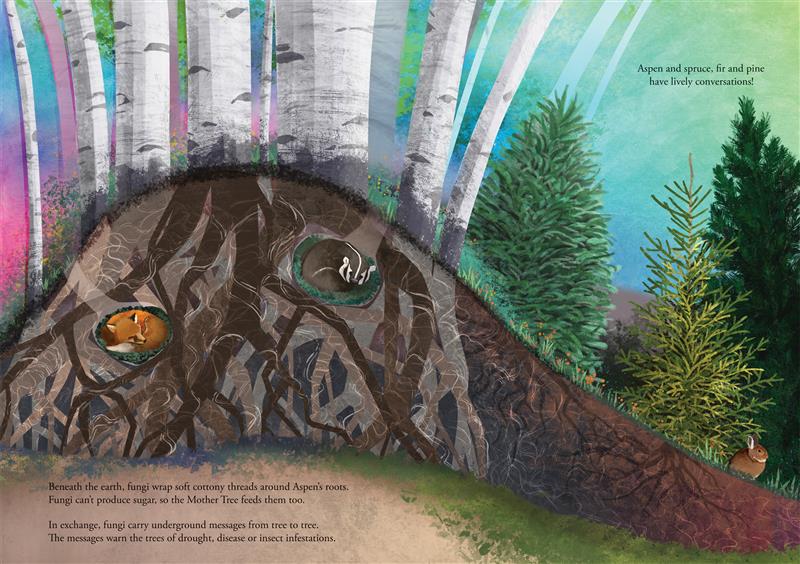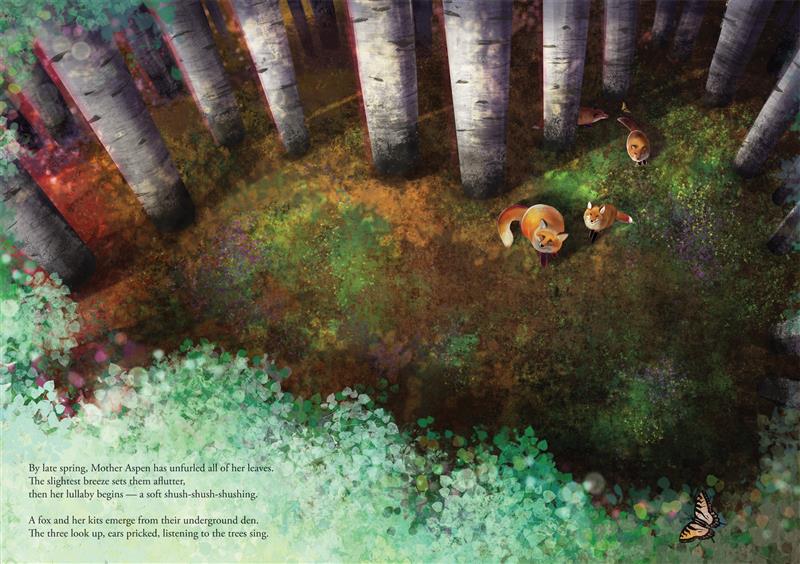A lyrical story of an aspen grove through the seasons, inspired by the ground-breaking work of Dr. Suzanne Simard on how trees and fungi talk to each other.
In early spring, the Mother Tree wakens. She is hundreds of years old, and her children are the sprouts that she sends up from her roots. They look like many separate trees, but they are all part of the Mother Tree.
Above ground, the aspens use the sun to produce sugar. Below ground, fungi wrap threads around the aspen’s roots, feeding on the sugar that they cannot make themselves. And in exchange, the fungi carry messages from tree to tree — warnings of drought, disease and infestations.
Through the seasons and years, the Mother Tree shelters and feeds the other trees, the animals that make their home in the grove and the fungi that make it possible for the trees to talk to each other. But when a violent storm upends the order of things, can the forest survive without its Mother Tree?
This story of symbiosis, richly illustrated by Crystal Smith, shows how the forest inhabitants thrive by working together. An author’s note explains the significance of mycorrhizal networks and why it is crucial to protect aspen forests.
Key Text Features
Illustrations
author’s note
further information
resources
Correlates to the Common Core State Standards in English Language Arts:
CCSS.ELA-LITERACY.RI.K.7
With prompting and support, describe the relationship between illustrations and the text in which they appear (e.g., what person, place, thing, or idea in the text an illustration depicts).
CCSS.ELA-LITERACY.RI.1.4
Ask and answer questions to help determine or clarify the meaning of words and phrases in a text.
CCSS.ELA-LITERACY.RI.2.3
Describe the connection between a series of historical events, scientific ideas or concepts, or steps in technical procedures in a text.
A lyrical story of an aspen grove through the seasons, inspired by the ground-breaking work of Dr. Suzanne Simard on how trees and fungi talk to each other.
In early spring, the Mother Tree wakens. She is hundreds of years old, and her children are the sprouts that she sends up from her roots. They look like many separate trees, but they are all part of the Mother Tree.
Above ground, the aspens use the sun to produce sugar. Below ground, fungi wrap threads around the aspen’s roots, feeding on the sugar that they cannot make themselves. And in exchange, the fungi carry messages from tree to tree — warnings of drought, disease and infestations.
Through the seasons and years, the Mother Tree shelters and feeds the other trees, the animals that make their home in the grove and the fungi that make it possible for the trees to talk to each other. But when a violent storm upends the order of things, can the forest survive without its Mother Tree?
This story of symbiosis, richly illustrated by Crystal Smith, shows how the forest inhabitants thrive by working together. An author’s note explains the significance of mycorrhizal networks and why it is crucial to protect aspen forests.
Key Text Features
Illustrations
author’s note
further information
resources
Correlates to the Common Core State Standards in English Language Arts:
CCSS.ELA-LITERACY.RI.K.7
With prompting and support, describe the relationship between illustrations and the text in which they appear (e.g., what person, place, thing, or idea in the text an illustration depicts).
CCSS.ELA-LITERACY.RI.1.4
Ask and answer questions to help determine or clarify the meaning of words and phrases in a text.
CCSS.ELA-LITERACY.RI.2.3
Describe the connection between a series of historical events, scientific ideas or concepts, or steps in technical procedures in a text.
| Published By | Groundwood Books Ltd — Sep 3, 2024 |
| Specifications | 32 pages | 8.5 in x 12 in |
| Written By |
ANNETTE LEBOX is a poet and an environmental activist who divides her time between Maple Ridge, British Columbia, and a remote cabin in the Cariboo grasslands. She has won the BC Book Prize for illustrated children’s literature twice: for Salmon Creek, illustrated by Karen Reczuch, and for Peace Is an Offering, illustrated by Stephanie Graegin, which was also selected for Dolly Parton’s Imagination Library. She is also the author of the YA novel Circle of Cranes. |
| Illustrated by |
CRYSTAL SMITH is the daughter of a lighthouse keeper who discovered her passion for wildlife when she was small. She illustrates the natural world to spark curiosity and wonder, kindle concern and illuminate issues. She has also illustrated Mother Aspen, written by Annette LeBox. Crystal currently lives in Victoria, BC. |
| Written By |
|
ANNETTE LEBOX is a poet and an environmental activist who divides her time between Maple Ridge, British Columbia, and a remote cabin in the Cariboo grasslands. She has won the BC Book Prize for illustrated children’s literature twice: for Salmon Creek, illustrated by Karen Reczuch, and for Peace Is an Offering, illustrated by Stephanie Graegin, which was also selected for Dolly Parton’s Imagination Library. She is also the author of the YA novel Circle of Cranes. |
| Illustrated by |
|
CRYSTAL SMITH is the daughter of a lighthouse keeper who discovered her passion for wildlife when she was small. She illustrates the natural world to spark curiosity and wonder, kindle concern and illuminate issues. She has also illustrated Mother Aspen, written by Annette LeBox. Crystal currently lives in Victoria, BC. |
| Audience | ages 3 to 6 / grades P to 1 |
| Key Text Features | Illustrations; author’s note; further information; resources |
| Common Core |
CCSS.ELA-LITERACY.RI.1.4
CCSS.ELA-LITERACY.RI.2.3 CCSS.ELA-LITERACY.RI.K.7 |




